#gaul
Explore tagged Tumblr posts
Text
Thinking about how Wyatt Callow is proof that Dr. Gaul’s and Snow’s assertion that humanity’s essential nature is violent (which is part of their argument for the Capitol’s control being necessary) is false. That “What happened in the arena? That’s humanity undressed… A boy with a club who beats another boy to death. That’s mankind in its natural state.” is false.
I’m sure he had it all calculated. He knew exactly what choices would give him the best odds of survival. He knew that the faster he got out of the initial bloodshed the better his chances would be. He knew that letting other kids die would benefit his odds of survival. He knew exactly what he should’ve done to preserve himself.
And yet, he threw all those statistics and odds, all that reason and logic out the window in the name of protecting Lou Lou, a girl that wasn’t even from his district. He threw it all out the window in the name of helping another human being that was in an unfair situation and had worse odds than him. He knew who the real enemy was; he knew it wasn’t the other kids being taken advantage of by the Capitol just like him.
That is humanity.
#wyatt deserves more love#wyatt is one of the best things to come out of this book#wyatt callow#wyatt#thg#sotr#sunrise on the reaping#my post#thg sotr#commentary#sotr spoilers#lou lou#suzanne collins#the hunger games#sunrise on the reaping spoilers#volumnia gaul#gaul
7K notes
·
View notes
Text

The Sacred Grove of the Druids, set design from Vincenzo Bellini's Opera ''Norma''
#vincenzo bellini#norma#opera#druids#druid#sacred grove#sacred groves#high priestess#woods#forest#art#gaul#gallic#ancient gaul#gauls#pagan#paganism#europe#european#ritual#rituals#ceremony#tradegy#oroveso#chief#antiquity#religion#roman#ancient rome#villeneuve
2K notes
·
View notes
Text
One of the most famous Greek depictions of a "barbarian" is the “Dying Gaul,” carved during the Hellenistic period in the 200s BCE.

This wounded soldier can be identified as a Gaul because of his metal neck ring and facial hair.
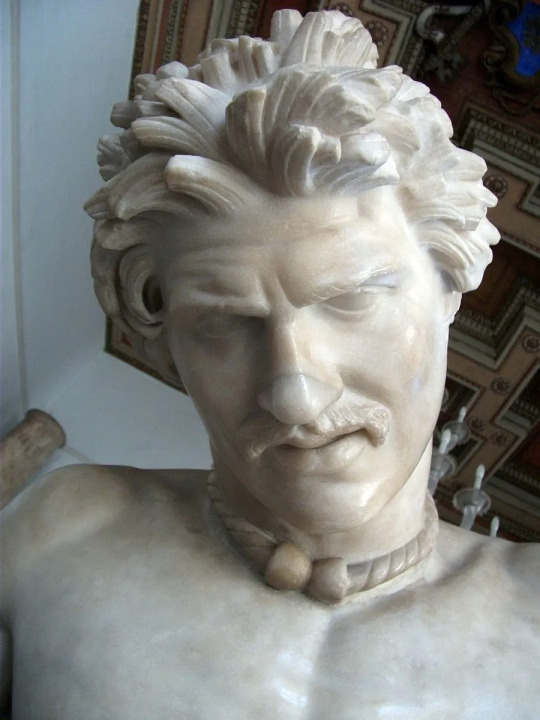
By the way, this man isn’t just naked because the Greeks often sculpted people in the buff. Gauls were famous for fighting naked — a sign of “barbarian boastfulness,” according to Dionysius of Halicarnassus.
{Buy me a coffee} {WHF} {Medium} {Looking Through the Past}
550 notes
·
View notes
Text

Iron Age Netherurd Gold Torc Terminal, 1st Century BCE, National Museums Scotland, Edinburgh
This terminal for a gold neck ring and two gold coins are all that remain of a large hoard of gold coins and neck rings found at Netherurd in Peeblesshire. The coins were minted in Gaul in the 1st century BCE, while the terminal fragment is an East Anglian type.
#ice age#stone age#bronze age#iron age#prehistoric#prehistory#neolithic#mesolithic#paleolithic#torc#gaul#celtic#archaeology#ancient crafts#ancient cultures#ancient living#metalwork#gold#wealth#status#Scotland#hoard
223 notes
·
View notes
Text
Sources for Celtic History and Paganism!
So today I was reading Ancient Fire: An Introduction to Gaulish Celtic Polytheism by Segomâros Widugeni when it struck me just how many of the sources were the type of thing that wouldn't necessarily come up on a regular search, particularly some out-of-print books, a lot of which are actually available on the Internet Archive! I took some time to take note of each listed source, and tried to see if I could find the right place to request them from (in the case of a handful of articles and theses), find PDF links where they did already exist, basically whatever I could! Some books are available to buy, most secondhand, and while most are available on Amazon, I won't be linking those here. I'd encourage anyone shopping to consider an alternative option if they can! Now, I haven't read through all of these, but the moment I found at least one of them seems to be impossible to find, I was reminded of the dangers of dying media. So I wanted to put these together so anyone could use them. Not every resource listed is in English. Anyway, on to the list~
Cernunnos: Looking a Different Way
By Ceisiwr Serith
https://ceisiwrserith.com/therest/Cernunnos/cernunnospaper.htm
Cernunnos Origin and Transformation of A Celtic Divinity
By Phyllis Fray Bober
https://www.scribd.com/document/460345187/cernunnos-origin-and-transformation-of-a-celtic-divinity-phyllis-fray-bober
Basic Celtic Deity Types
by Alexei Kondratiev
https://naomh-na-tursan.livejournal.com/5752.html
Deep Ancestors: Practicing the Religion of the Proto-Indo-Europeans
Book by Ceisiwr Serith
https://www.scribd.com/document/362472999/Deep-Ancestors-Practicing-the-Religion-of-the-Proto-Indo-Europeans
The Gods of the Celts and the Indo-Europeans
Book by Garrett S. Olmsted
https://www.academia.edu/38135817/The_Gods_of_the_Celts_and_the_Indo_Europeans_revised_2019_
Dictionary of Celtic Myth and Legend
Book by Miranda Aldhouse-Green
https://www.thriftbooks.com/w/dictionary-of-celtic-myth-and-legend_miranda-aldhouse-green/543335/#edition=5215209&idiq=16154030
The Book of The Great Queen: The Many Faces of the Morrigan from Ancient Legends to Modern Devotions
Book by Morpheus Ravenna Further
to tongu do dia toinges mo thuath [“Mi a dyngaf dynged it”], &c.
By John Koch
https://www.academia.edu/7242277/Further_to_tongu_do_dia_toinges_mo_thuath_Mi_a_dyngaf_dynged_it_and_c
Goddesses in Celtic Religion Cult and Mythology: A Comparative Study of Ancient Ireland, Britain and Gaul
By Noémie Beck
http://theses.univ-lyon2.fr/documents/lyon2/2009/beck_n#p=0&a=title
The Integration of Mercury and Lugus: Myth and History in Late Iron Age and Early Roman Gaul
By Krista Ovist
https://archives.library.wales/index.php/integration-of-mercury-and-lugus
Lady with a Mead Cup: Ritual, Prophecy, and Lordship in the European Warband from La Tène to the Viking Age
Book by Michael J. Enright
How to Kill a Dragon: Aspects of Indo-European Poetics
Book by Calvert Watkins
https://ia801404.us.archive.org/view_archive.php?archive=/7/items/twain-mark-a-connecticut-yankee-in-king-arthurs-court/1-ptry.zip&file=How%20to%20Kill%20a%20Dragon%20-%20Aspects%20of%20Indo%20European%20Poetics.pdf
The Celtic Gauls: Gods, Rites and Sanctuaries
Book by Jean-Louis Brunaux
The Apple Branch: A Path to Celtic Ritual
Book by Alexei Kondratiev
https://archive.org/details/applebranchpatht0000kond
Oxford Dictionary of Celtic Mythology
Book by James Mackillop
https://archive.org/details/dictionaryofcelt0000mack
The female deities of the Celtic religion: worship and mythology: a comparative study of ancient Ireland, Great Britain and Gaul
By Noémie Beck
https://theses.fr/2009LYO20084
Celtic Curses
Book by Bernard Mees
https://www.academia.edu/1012094/Celtic_Curses_Woodbridge_Boydell_2009
Guide to Irish Mythology
Book by Daragh Smyth
https://archive.org/details/guidetoirishmyth00smyt
The Sacred Isle
Book by Dáithí Ó hÓgáin
https://archive.org/details/sacredislebelief0000ohog
The Matronae and Matres: Breathing New Life into an Old Religion
By River Devora
http://polytheist.com/the-web-of-blessings/2015/08/12/the-matronae-and-matres-breathing-new-life-into-an-old-religion/
Interpretatio Romana and Matronae Iconography
By River Devora
http://polytheist.com/the-web-of-blessings/2015/08/31/interpretatio-romana-and-matronae-iconography/#:~:text=The%20overlay%20of%20interpretatio%20Romana,and%20plaques%20and%20glean%20valuable
Celtic chiefdom, Celtic state: the evolution of complex social systems in prehistoric Europe
By Arnold, Bettina and Gibson, D. Blair
https://searchworks.stanford.edu/view/3086499
*butacos, *wossos, *geistlos, *ambactos. Celtic Socioeconomic Organisation in the European Iron Age. Studia Celtica 40, 2006: 23-41
By Raimund Karl
https://www.academia.edu/245239/_butacos_wossos_geistlos_ambactos_Celtic_Socioeconomic_Organisation_in_the_European_Iron_Age_Studia_Celtica_40_2006_23_41
The Ancient Celts
Book by Barry Cunliffe
https://archive.org/details/ancientcelts00cunl_0
Sengoidelc: Old Irish for Beginners
Book by David Stifter
https://archive.org/details/sengoidelcoldiri0000stif
Greek Kελτóς and Γαλάτης, Latin Gallus ‘Gaul’
By Kim McCone
https://spr.harrassowitz-library.com/article/spr/2006/1/6
Celtic Heritage: Ancient Tradition in Ireland and Wales
Book by Alwyn and Brinley Rees
https://archive.org/details/in.gov.ignca.36494
Celtic Reconstructionist Paganism
By Erynn Rowan Laurie, Kathryn Price NicDhàna, Aedh Rua Ó Mórríghan, Kym Lambert ní Dhoireann and John Machate, ed. by Erynn Rowan Laurie
https://web.archive.org/web/20080418025755/http://www.witchvox.com/va/dt_va.html?a=usma&c=trads&id=6645
Which witch is which? : a concise guide to Wiccan and Neo-Pagan paths and traditions
Book Compiled and Edited by Patricia Telesco
Sources for the Three Realms
By Annie Loughlin - original source link is dead, need help to locate!
Dictionnaire de la Langue Gauloise
Book by Xavier Delmarre
https://archive.org/details/dictionnairedelal00dela (referred to as “Essential for Gaulish Language study)
The Settling of the Manor of Tara
By R.I. Best
https://www.ucd.ie/tlh/trans/rib.eriu.4.001.t.text.html
The court of law in Iron Age ‚Celtic’ societies. In R. Karl & J. Leskovar (eds.), Interpretierte Eisenzeiten 3. Fallstudien, Methoden, Theorie. Tagungsbeiträge der 3. Linzer Gespräche zur interpretativen Eisenzeitarchäologie. Studien zur Kulturgeschichte von Oberösterreich Folge 22, Linz: Oberösterreichisches Landesmuseum 2009: 135-60.
By Raimund Karl
https://www.academia.edu/245221/The_court_of_law_in_Iron_Age_Celtic_societies_In_R_Karl_and_J_Leskovar_eds_Interpretierte_Eisenzeiten_3_Fallstudien_Methoden_Theorie_Tagungsbeitr%C3%A4ge_der_3_Linzer_Gespr%C3%A4che_zur_interpretativen_Eisenzeitarch%C3%A4ologie_Studien_zur_Kulturgeschichte_von_Ober%C3%B6sterreich_Folge_22_Linz_Ober%C3%B6sterreichisches_Landesmuseum_2009_135_60
Matasović Etymological Dictionary Of Proto Celtic
By Ranko Matasović
https://archive.org/details/matasovic-etymological-dictionary-of-proto-celtic
Hammer of the Gods: Anglo-Saxon Paganism in Modern Times Second Edition
Book by Swain Wodening
https://archive.org/details/hammerofgodsangl0000swai
Various Works by Christopher Scott Thompson - recommended re: honor in Gaulish society
https://cateransociety.wordpress.com/books/
A Handbook of the Scottish Gaelic World
Book by Michael Newton and Michael Steven Newton
Celtic Values
By Alexei Kondratiev
http://dagdacelt.freehostia.com/values.html
European paganism : the realities of cult from antiquity to the Middle Ages
By Ken Dowden
https://archive.org/details/europeanpaganism0000dowd
A Definitive Reconstructed Text of the Coligny Calendar
By Garrett Olmsted
https://www.academia.edu/62011364/A_Definitive_Reconstructed_Text_of_the_Coligny_Calendar
New Calendar of Gaulish Polytheism
By Jess via Nemeton Nigromanitcos
https://thebloodybones.wordpress.com/2015/07/10/new-calendar-of-gaulish-polytheism/#more-265
Calendar of Feast-Days of Deities
Via the blog Deo Mercutio
https://deomercurio.wordpress.com/calendar-of-feast-days-of-deities/
Altkeltische Sozialstrukturen
By Raimund Karl
https://homepage.univie.ac.at/Raimund.Karl/Sozialstrukturen.pdf
La Langue Gauloise
Book by Pierre-Yves Lambert
https://www.scribd.com/document/782869557/Lambert-1994-La-langue-gauloise-description-linguistique-commentaire-d-inscriptions-choisies
Death, War, and Sacrifice: Studies in Ideology & Practice
Book by Bruce Lincoln
The Gods of the Celts
Book by Miranda Aldhouse-Green
https://archive.org/details/godsofceltsar00mira
War Goddess The Morrigan And Her Germano Celtic Counterparts
Book by Angelique Gulermovich Epstein
https://archive.org/details/WarGoddessTheMorriganAndHerGermanoCelticCounterparts
Epigraphik-Datenbank Clauss/Slaby
- Database of “almost all inscriptions ever recorded”
https://db.edcs.eu/epigr/hinweise/hinweis-en.html
A website on Gallo-Roman religion:
http://www.deomercurio.be/en/
A scholarly website with information on Epona:
https://epona.net/
#witch#witchcraft#magic#witchblr#witchy#pagan#paganism#resources#pagan resources#celtic#celtic pagan#roman pagan#gaulish#gaulish paganism#gaulish polytheism#advwitchblr#continental celtic#Cernunnos#Kernunnos#the morrigan#celtic paganism#polytheism#Gaul#Irish paganism
58 notes
·
View notes
Text

Karel Lodewijk De Kesel (Belgian, 1849-1922) The Roman Invasion of Gaul, 1894 Museum of Fine Arts, Ghent Regarding the Hellenes and the Barbarians; Greeks called themselves Hellenes, and thus historians use the term Hellenistic to describe the complex cosmopolitan civilization, based on that of Greece, that developed in the wake of Alexander's conquests. Greek culture became the standard by which civilized people identified themselves. Convinced of their intellectual and cultural superiority over inferior people--an idea promoted by the philosophy of Aristotle, Alexander the Great's tutor--civilized people referred to those who did not speak Greek as barbarians, a term derived from the Greeks' description of these people's language as "ba-ba," meaning unintelligible to Greeks. Aristotle also contended that the Greeks were an ideal people because they possessed a medium skin-tone, in contrast to pale northerners. The Greek and Roman people considered the Germanic and some Celtic peoples to be wild, red haired barbarians.
#Karel Lodewijk De Kesel#Gaul#Gauls#Germanic tribes#Germanic#Celtic#Celt#art#fine art#european art#classical art#europe#european#fine arts#oil painting#europa#mediterranean#Belgian art#Belgian#Belgium#Netherlands#western civilization#Aristotle#ancient tribalism#ancient history#the hellenes#hellenes#barbarians
27 notes
·
View notes
Text
Atepomaros et le sang-mort
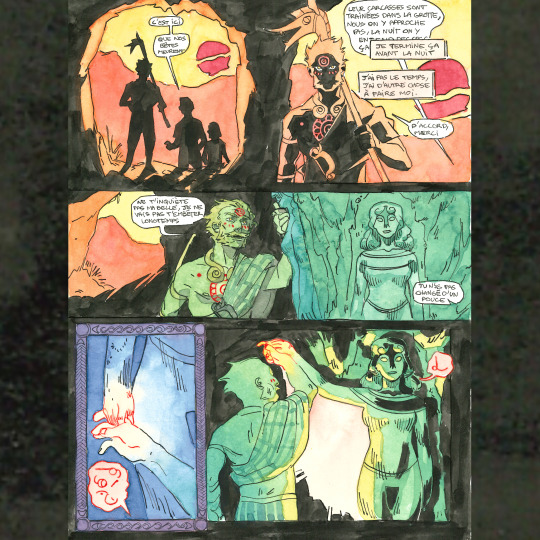
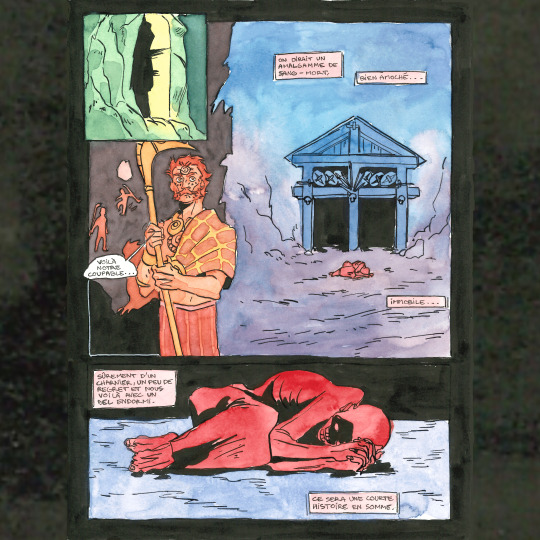
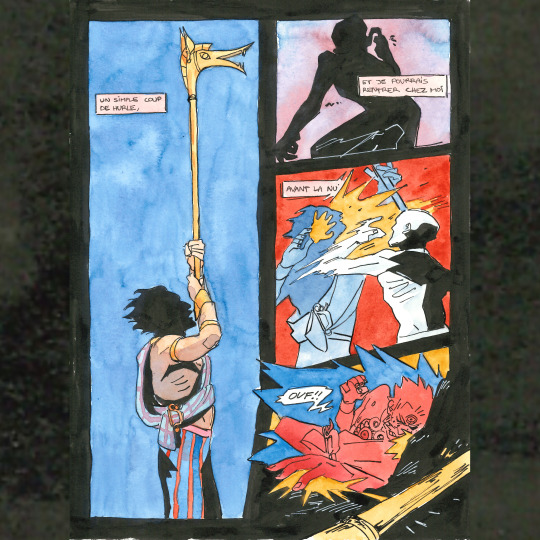
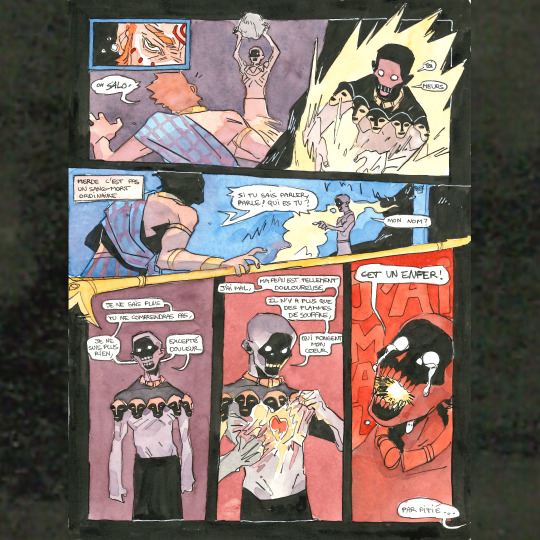
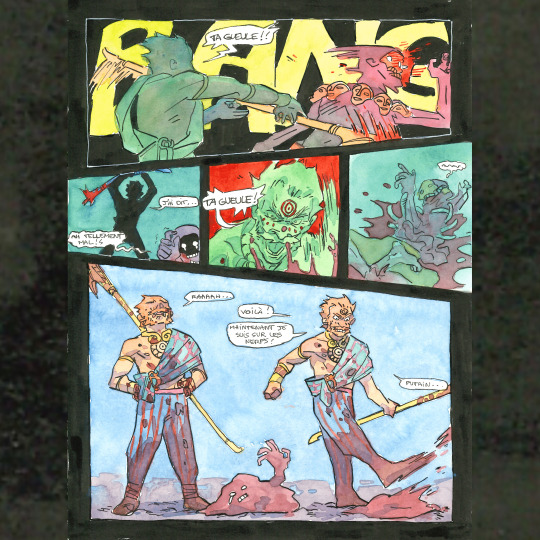
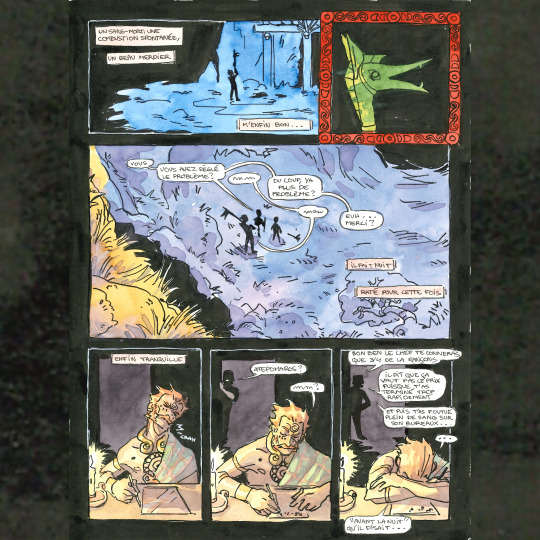
Un one-shot sur un de mes personnages que j'aime le plus (c'est un peu aussi ma pp).
J'ai l'intention de le développer dans de prochaines pages ;)



40 notes
·
View notes
Text
Here’s a little something I kinda wanna write:
A TBOSAS High School AU but different, because it’s still in Panem. When they’re discussing what could be done to make the Games more interesting in class, Sejanus goes a little mad with rage when Clemensia suggests making these poor kids avoxes like being a slave without a tongue is a better fate than the arena and decides to bitterly make a suggestion he knows will never be picked anyway:
Why not prove how “inferior” those district kids are by having them go to the Capitol Academy from the reaping ceremony until the end of the year? That’ll get people invested in the games! Now they know these kids and they get to enjoy watching them die after being forced to be around them for so long! 🙄
Except Gaul actually thinks this is genius, what with her whole “all humans are vicious animals when cornered” philosophy, and what do you know? That year’s tributes have to spend several months in the lion’s den before they’re sent into the arena. They all take this news with varying degrees of disgust and resignation, especially because they still have to spend a few nights in the zoo while the Capitol decides on where to lock them up. In the end the tributes are thrown into a hotel, specifically the part that used to be a safe house during the Dark Days. It’s the lowest quality place to stay in the Capitol that is, actually, a place for humans to stay, but it’s more luxurious than anything the tributes have ever seen before.
Throughout their stay there, the tributes end up bonding with Capitol citizens with various levels of intent. For some, like Pup and Lamina or Persephone and Mizzen or Lysistrata and Jessup, it goes pretty naturally even without the mentorship because of various situations through which they end up coming into contact. For some, like Bobbin and Panlo and Brandy and Coral, it flat out doesn’t happen. For some like Sejanus and Marcus, it’s a rocky road to a happy ending.
For others like Treech and Vipsania, it’s absolutely hilarious. Not to them, but to the other tributes + Sejanus.
See, despite the Capitol’s disbelief, some tributes actually scored higher than their own age bracket in the school curriculum and got placed in higher classes under the assumption that it was a fluke and they’ll fail out eventually. A good example would be Teslee and Circ on everything tech and Otto and Ginnee on everything mechanical. Treech scored exceptionally high on both history and literature because A) he needed to know a lot of those stories for wood-carving and B) he’s a sneaky bitch who’s broken into the peacekeeper barracks and stole their books on too many occasions to count. He learned those stories to tell the younger kids when he ran out of folklore to entertain the exceptionally story-hungry ones with. Therefore, his 15-year-old self is stuck in the mentors’ class of 18-19yo people. Sadly for him, literature ends up having a big year-long duo project where you have to read and analyze several books together for practice and, at the end of the year, put together a presentation on anything literature analysis related together.
Treech gets stuck with Vipsania.
Everyone in that class feels terrible for her because they’re all convinced he can’t even read, partially because when people make ‘jokes’ about that he doesn’t bother correcting them. He just shares an exasperated look with Sejanus and moves on, because Sejanus knows Treech can read and write due to his wood carving job (he works two jobs bless his soul) and they can bitch about these people after class when Treech doesn’t risk these fragile ego having assholes to get him executed. The thing is though- Treech is actually amazing at writing stories, and that translates to him being very good at writing papers and analyzing stories for someone who’s never done so in an education setting. Vipsania won’t give him a chance though, and keeps belittling him and condescending to him until he snaps and suggests they make their papers separately so he won’t “drag her grade down” outside of the final presentation. She agrees.
At some point, Treech is called into Dean Highbottom’s office during a biology class (he’s with students his age and even made a friend!! Who’s currently helping him catch up on all the education he missed) for a bit and comes back into class looking both pissed off and pleased with himself. The next literature class the grades are announced and the professor looks pale as he announces the highest grade in the class belonging to Vipsania Sickle and Treech Meran, with their shared average of 9.2. People congratulate Vipsania, only for the professor to announce her grade to be an 8.6, the third highest grade in the class. The person with highest individual grade in the class is Treech, who’s leaning his head against his hand and staring out the window in boredom as the students stare at him in shock.
A 9.8, the highest grade in the entire year.
When people suggest there must be a mistake, the professor shakily admits they verified it’s his handwriting and he repeated enough points from the paper that they can only accept he wrote it until there’s tangible proof to claim the opposite, which there isn’t. After that, Vipsania takes some time to simmer in her anger at being outdone by some lesser creature, only to be forced to accept he beat her fair and square in a way where she couldn’t claim credit. So instead she decides she can suck it up and work with him for the project. Except now she’s genuinely interacting with him, and that leads to her to stop despising him. When he complains PE is boring and he misses some of the physical exercise he got back in 7 (especially with his theater troupe), Vipsania ends up convincing her aunt to let him into the gymnasium. Which ends with him joining the track team (because in his words: “gymnastics is for the theater, sprinting is for always”).
And somewhere down the line they go from begrudging project partners to sort of friends maybe, even though Treech still kinda hates her guts for being a prejudiced bitch to him.
The other tributes and Sejanus just adore seeing Capitol dicks be put in their place, and Treech gets to do it in literature, history, and track. Treech is a little less amused because his talking time with his bio buddy was cut short so the Academy could have him write random sentences on paper for 20 minutes until the lit professor was finally forced to accept he wrote that paper.
Either way, a lot of the tributes get Capitol friends who really don’t like the idea of watching them die actually, so of course having the entire youth and even some respected Capitol professors protesting the games puts enough pressure on the academy board to force even the anti-district assholes to agree to put the tributes under Academy protection. No games for Gaul!! No job for Gaul either, she gets fired for unspecified “misconduct”.
She tried to go after Treech and Lucy Gray for becoming so popular with the students, so Agrippina, the literature professor, history professor and art/music professor banded together to stop her because those two are their favorite students. They produce good, creative work that’s actually fun to grade and they need some good projects to stay sane.
#the ballad of songbirds and snakes#tbosas#the hunger games#10th hunger games#hunger games#treech#treech tbosas#tbosas treech#treech thg#fix it au#high school au#lucy gray baird#lucy gray#sejanus plinth#literature project#group project#crack#ish#no more hunger games#gaul#volumnia gaul#vipsania sickle#agrippina sickle
34 notes
·
View notes
Text
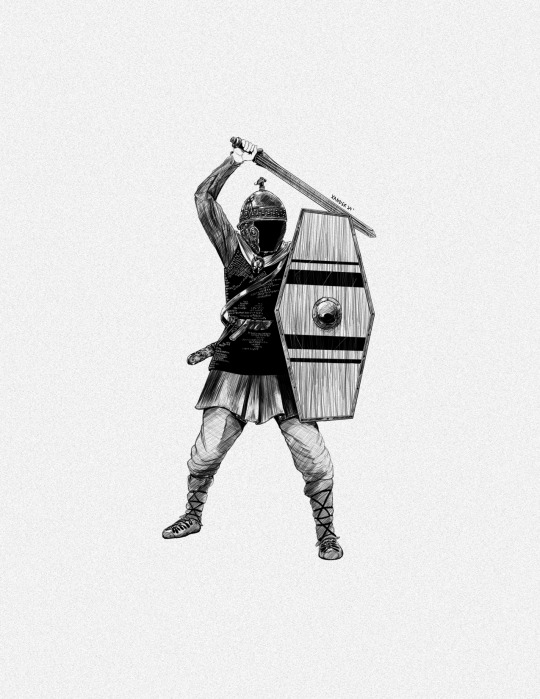
The Gaul - Gallic Warrior
#art#illustration#design#digital art#drawing#drawdrawdraw#character design#sword#rpg#dnd#gaul#gallic#warrior#celt#armor#chainmail#swords#helmet#artist#fantasy art#history#historical
62 notes
·
View notes
Photo

This map illustrates the administrative and geopolitical situation in Roman Gaul two centuries after the Roman conquest, which began with Julius Caesar's campaigns (58–51 BCE), bringing the region under Roman control. By 200 CE, Gaul was fully integrated into the Roman Empire and divided into provinces such as Gallia Narbonensis, Gallia Lugdunensis, Gallia Belgica, and Germania Inferior and Germania...
34 notes
·
View notes
Text

🐎Epona👑 Gaulish/Celtic Goddess of Horses and Sovereignty
#sketchbook#sketch#my art#fanart#art#paganism#celtic mythology#mythology#gaulish#gaul#celtic#epona#epona goddess
36 notes
·
View notes
Text

Carolingian Child King by Jean-Paul Laurens
#jean paul laurens#art#carolingian#king#frankish#franks#carolingian empire#nobility#royalty#french#france#francia#gaul#germanic#ancien régime#medieval#middle ages#history#europe#european#royal#sceptre#throne#crown#monarch#monarchy#regal#christian#christianity#christendom
259 notes
·
View notes
Text

Trust me, you don't KNOW the pain of dealing with a death hound until you're forced to deal with a whole pack of them.
And I played the game TWICE just so I could unlock dark spyro and upgrade the breaths to the max!!
like or reblog if you save/use.
#tumblr fyp#tumblr funny#instagram#luchipuchi's gallery#meme#memes#meme template#shen comix#video games#bluechair#spyro#spyro the dragon#the legend of spyro#tlos#the eternal night#gaul#arborick#death hounds#annoying enemies
22 notes
·
View notes
Text

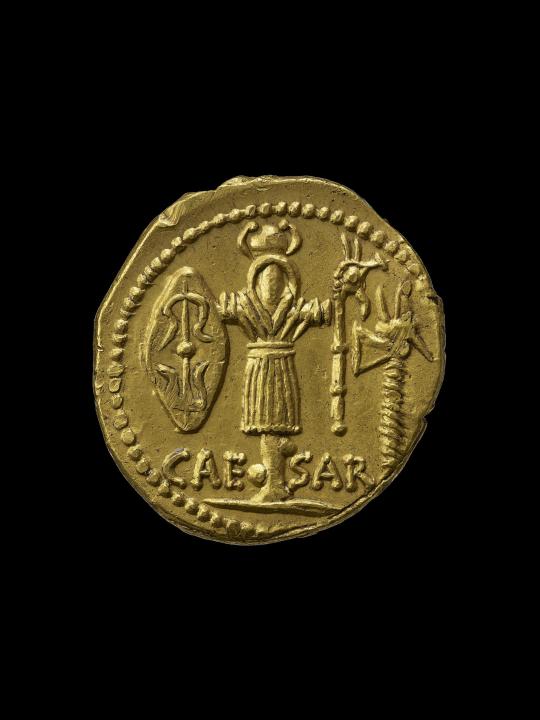
Aureus with female head wearing oak wreath (obverse) and trophy with Gallic shield and carnyx (reverse), minted under Julius Caesar
Roman, Republican Period, after July 13, 48 B.C.
gold
British Museum
#Ides of March#Julius Caesar#Caesar#coin#numismatics#Gallic Wars#Gaul#carnyx#trophy#Roman Republic#Ancien Rome#Roman#gold#British Museum
96 notes
·
View notes
Note
Gaul and 12 and 14 ehehehehhehe
OK. SORRY THE DELAY NELL BUT HEREE ITS.
I dont remember which one was but one of the questions was abt assignate an aesthetic to this character. I dont know a lot abt aesthetics but I think kitsch and clown its in general the ones I would give to Gaul.
I visualized this mostly in clothes but in her youth I think it was bc of Gaulnon draw for some reason got in my head she could got those empresarial 80s suits with marked shapes and bright colors and that develop with time in she going more silly with more clown or funny clothes. That end in she to me in my head going hard over the kitsch vibe.
Shes wearing worst mixing, shes "bad taste" in a human body but she slay for that reason. I actually like her aesthetic in the movie. I think only think I miss its she should got more different shapes.
Also a fun imagen I found random on pinterest when I was looking the other pics KSKSKS I was personal attacked by pinterest









And the other question was a hc for her.
I support so hard the Gaul would invent M preg. The best concept but aside from that I really like thing Gaul especialized in neonatal surgery. I THINK FIT HER PERSONALITY IN A WAY and would be a nice way to avoid for a while the parts she wasnt a fan in ostreticia.
14 notes
·
View notes
Text



Today's Celtic character of the day is Asterix from Asterix who is Gaul (ancient Celt). He is from the fictional village in northwest Armorica.
15 notes
·
View notes